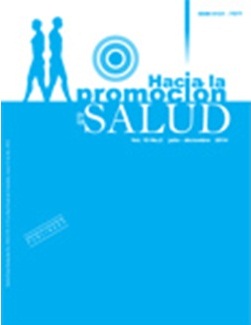Authors
Abstract
Objective: To analyze physical and general self-concept, concern about physical appearance and obesity as well as eating habits in the school context, in children between 9 and 13 years old in two highly marginalized contexts in Mexico. Materials and Methods: Mixed, non-experimental, descriptive and cross-sectional investigation in two stages: in the first stage a survey technique was used and the in the second stage photographic evidence and the opinion of an expert in food biotechnology were used. A total of 490 fifth and sixth grade elementary school students participated. Results: Positive general and physical self-concept in children was found, with very few significant differences between boys and girls. Although children of both sexes have normal weights and heights according to their age, there is a great concern and interest in obesity, but also food consumption dynamic in the school context with high caloric content, poor in nutrients and that promotes obesogenic lifestyles. Conclusions: Complexity in the perception of the students regarding their self-concept and eating habits is evident. The need to design educational strategies in a cross-curricular manner to transform children’s wrong ideas about the self image, that of others and healthy eating habits, is emphasized.
References
Gutiérrez JP. Encuesta Nacional de Salud y Nutrición 2012. Resultados nacionales. Cuernavaca, Morelos. México: Instituto Nacional de Salud Pública; 2012.
Tomlinson A. Consumption, Identity and Style. London: Routledge; 1990.
French S, Story M, Jeffery R. Environmental influences on eating and physical activity. Annu Rev Public Health. 2001; 22(1): 309-335.
Beardsworth A, Keil T. Sociology on the Menu. London: Routledge; 1998.
Buckingham D. The material child. Growing up in Consumer Culture. U. K.: Polity; 2011.
Brownell C, Zerwas S, Ramani GB. “So Big”: The Development of Body Self-Awareness in Toddlers. Child Development. 2007; 78(5): 1426-1440.
Harter S. The construction of the self. A developmental perspective. London: Guilford Press; 1999.
Franco C. Relación entre las variables autoconcepto y creatividad en una muestra de alumnos de educación infantil. Rev Electron Investig Educ [Internet]. 2006; 8(1): 1-16. Disponible en: http://redie.uabc.mx/vol8no1/contenido-franco.html
Strong W, Malina RM, Blimkie CJR, Daniels SR, Dishman R, Gutin B, Hergenroeder AC, Must A, Nixon PA, Pivarnik JM, Rowland T, Trost S, Trudeau D. Evidence based pshysical activity for school-age youth. J Pediatr. 2005; 146: 732-737.
Braken BA. Mutidimensional self-concept scale. Austin: Pro-Ed; 1992.
Marsh HW, Richards GE, Johnson S, Roche L, Tremayne P. Physical Self-Description Questionnarie: Psychometric properties and a multitrait-multimethod analysis of relation to existing instruments. J Sport Exerc Psychol. 1994; 16: 270-305.
Goñi A, Ruiz de Azúa S, Liberal I. Propiedades psciométricas de un nuevo cuestionario para la medida del autoconcepto físico. Rev Psic Dep. 2004; 13(2): 195-213.
Argyle M. The Psychology of Happiness. New York: Routledge; 2013.
Denny K. Beauty and intelligence may-or may not – be related. Intelligence. 2008; 36: 616-618.
Feingold A. Good-looking people are not what we think. Psychol Bull. 1992; 111(2): 304-341.
Holder MD, Coleman B. The contribution of temperament, popularity, and physical appearance to children’s happiness. J Happiness Stud. 2008; 9(2): 279-302.
Willows ND, Ridley D, Raine KD, Maximova K. High adiposity is associated cross-sectionally with low self-concept and body size dissatisfaction among indigenous Cree schoolchildren in Canada. BMC Pediatr. 2013; 13(1): 1-18.
Kerlinger FN, Lee HB. Investigación del comportamiento. México: McGraw-Hill; 2002.
Páez S. La Resurrección y Santa María Xonacatepec entre colonias más pobres. Ret Diario [Internet]. 2012. [acceso 10 de diciembre de 2013]. Disponible en: http://www.retodiario.com/desplieguenoticia2012.php?id=35444
Vargas D. Prevalencia de obesidad en preescolares en un jardín de niños. Poza Rica, México: Instituto Mexicano del Seguro Social, Universidad Veracruzana; 2010.
Necesidades nutricionales del ser humano. Disponible en: http://www.fao.org/docrep/014/am401s/am401s03.pdf
Leal A. Ácidos grasos trans, cops y lops: evidencia actual de su influencia sobre la salud infantil. Nutrición infantil, 2005; 63: 22-26.
Fernández-Michel SG, García-Díaz CL, Alanís-Guzmán MG, Ramos-Clamont MG. Ácidos grasos trans: consumos e implicaciones en la salud en niños. Ciencia y Tecnología Alimentaria. 2008; 6(1): 71-80.
Laboratorio Profeco. Frituras al Desnudo ¿Qué se esconde detrás del sabor? Rev Consum [Internet]. 2012. [acceso 5 de marzo de 2014]; abril, 46-55. Disponible en: http://revistadelconsumidor.gob.mx/wp-content/uploads/2012/04/RC422_049-frituras.pdf
Sánchez R. La química del color en los alimentos. Rev Quim Viva. 2013; 3(12): 234-246.
Lau S. Crisis and Vulnerability in Adolescent development. J Youth Adolesc. 1990; 19(2): 111-131.
Hay I, Ashman AF. ‘The development of adolescents’ emotional stability and general self-concept: the Interplay of parents, peers, and gender. Int J Disabili, Dev Educ. 2003; 50(1): 77-91.
Marsh HW, Craven RG. Reciprocal effects of self-concept and performance from a multidimensional perspective: Beyond seductive pleasure and unidimensional perspectives. Perspect Psychol Sci. 2006; 1: 133-163.
Chong WH. The role of personal agency beliefs in academic self-regulation: an Asian perspective. Sch Psychol Int. 2007; 28(1): 63-76.
Sebastian C, Burnett S, Blakemore SJ. Development of the self-concept during adolescence. Trends in Cogn Sci. 2008; 12(11): 441-446.
Santos Muñoz S. La educación física escolar ante el problema de la obesidad y el sobrepeso. Rev Int Med Cienc Activ Fis Dep. 2005; 5(19): 179-199.
Kline S. Globesity, Food Marketing and Family Lifestyles. New York: Palgrave; 2011.
Blancas AS, Escobar C. Activación progresiva de áreas cerebrales inducida por la ingestión diaria de una golosina dulce. Gac Med Mex. 2013; 149: 272-279.
Campos P, Saguy A, Ernsberger P, Oliver E, Gaesser G. The epidemiology of overweight and obesity: public health crisis or moral panic? Int J Epidemiol. 2006; 35: 55-60.
Secretaría de Salud. Acuerdo Nacional para la Salud Alimentaria. Estrategia contra el sobrepeso y la obesidad. México: Secretaría de Salud; 2010.
Catalán VG. La transversalidad y la escuela promotora de salud. Rev Esp Salud Pública. 2001; 75(6): 505-516.
Paiva F. Eu era assim. Infância, Cultura e Consumismo. São Paulo: Cortez Editora; 2009.


 PDF (Español)
PDF (Español)
 FLIP
FLIP






















